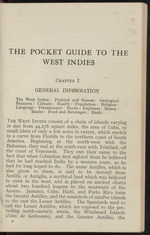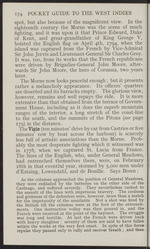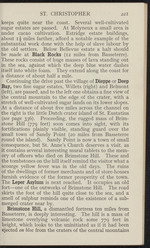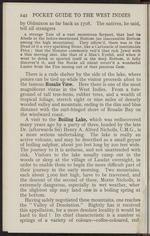| 1 |
 |
“...THE POCKET GUIDE TO THE
WEST INDIES
Chapter I
GENERAL INFORMATION
The West Indies : Position and Names : Geological
Features : Climate : Health : Population : Religion :
Language : Freemasonry : Books : Expenses : Money :
Banks : Food and Beverages : Meals.
The West Indies consist of a chain of islands varying
in size from 44,178 square miles, the area of Cuba, to
small.islets of only a few acres in extent, which stretch
in a curve from Florida to the northern coast of South
America. Beginning at the north-west with the
Bahamas, they end at the south-east with Trinidad, off
the coast of Venezuela. They owe their name to the
fact that when Columbus first sighted them he believed
that he had reached India by a western route, as he
had for long hoped to do. The name Antilles, which is
also given to them, is said to be derived from
Antilla, or Antiglia, a mythical land which was believed
to exist in the west, and is placed on ancient charts
about two hundred leagues to the westward of the
Azores...”
|
|
| 2 |
 |
“...156 POCKET GUIDE TO THE WEST INDIES
SPORTS. The Grenada Cricket Club has a picturesque
ground a quarter of a mile from St. George’s, where Cricket and
Football are played. At Grande Ance Bay, which is reached
by boat in half an hour from the Carenage, there is a fine stretch
of sandy beach, from which the bathing is perfect. Boats can
be hired at the Carenage. The sea Fishing is good, and the rivers
can be fished for mullet, brochet, sard, and mud-fish. The
natives use avocado pears, green grass-hoppers, red bananas,
and sometimes worms and cockroaches as bait. The St. An-
drew’s Racing Club, founded in 1897, holds flat Races periodically,
and race meetings are held at Queen’s Park, St. George’s, occasion-
ally, and also at Grenville on New Year’s Day and at Easter.
Rifle-shooting is encouraged by the St. George’s Rifle Club,
founded in 1907, which has its range at the Queen’s Park.
CLUBS. The St. George’s Club, which was opened in 1888,
and faces the Carenage, is very hospitable. Next...”
|
|
| 3 |
 |
“...Botanic Station, which owes its inception to Dr.
(now Sir) Daniel Morris, is situated at the foot of Rich-
mond Hill, only five minutes distant by boat from St.
George s. It was established in 1886, since which year
it has made rapid progress. Many valuable trees have
been planted and the gardens have a nursery for the
growth and distribution of plants.
At Grand Ance Bay (a row of about 30 minutes from
the wharf; fare 2s. (48c.) per person), to the south of St
Georges, there is an exquisite stretch of sandy beach
(from which delightful sea-bathing can be enjoyed
The Government have provided a landing-stage, and
the use of a bathing house can be had for a charge of
6a. (12c.) per head.
The Quarantine Station (2s. (48c.) per passenger by
boat from St. George’s), is a favourite resort for picnics.
When not required for their legitimate purpose the
buildings can be rented at a reasonable rate.
Government House stands on rising ground about
320 feet above the sea-level, overlooking the town...”
|
|
| 4 |
 |
“...that the French republicans
were driven by Brigadier-General John Moore, after-
wards Sir John Moore, the hero of Corunna, two years
later.
The Mome now looks peaceful enough; but it presents
rather a melancholy appearance. Its officers’ quarters
are deserted and its barracks empty. The glorious view, .
however, remains and well repays the ride. It is more
extensive than that obtained from the terrace of Govern-
ment House, including as it does the superb mountain
ranges of the interior, a long stretch óf the coast-line
to the south, and the summits of the Pitons (see page
179) in the distance.
The Vigie (ten minutes’ drive by car from Castries or five
minutes’ row by boat across the harbour) is scarcely
less full of artistic associations than the Mome. Prob-
ably the most desperate fighting which it witnessed was
in 1778, when we captured St. Lucia from France.
The lines.of the English, who, under General Meadows,
had entrenched themselves there, were, on February
18th in that eventful year...”
|
|
| 5 |
 |
“...estate a halt should
be made at Black Rocks (12 miles from Basseterre).
These rocks consist of huge masses of lava standing out
in the sea, against which the deep blue water dashes
itself into white foam. They extend along the coast for
a distance of about half a mile.
Continuing the drive past the village of Dieppe or Deep
Bay, two fine sugar estates, Willets (right) and Belmont
(left), are passed, and to the left one obtains a fine view of
the central mountain to the edge of the crater, with a
stretch of well-cultivated sugar lands on its lower slopes.
At a distance of about five miles across the channel on
the right is the little Dutch crater island of St. Eustatius
(see page 336). Proceeding, the rugged mass of Brim-
stone Hill (779 feet) soon comes into sight, with its
fortifications plainly visible, standing guard over the
small town of Sandy Point (20 miles from Basseterre
round the island). Sandy Point is now a town of small
consequence, but St. Anne’s Church deserves a visit, as
it...”
|
|
| 6 |
 |
“...Man’s Eyelid, and when it
went to drink or sported itself in the deep Bottom, it fully
discover'd it, and the Rocks all about receiv'd a wonderful
Lustre from the Fire issuing out of that precious Gem.
There is a rude shelter by the side of the lake, where
ponies can be tied up while the visitor proceeds afoot to
the famous Rosalie View. Here there is one of the most
magnificent vistas in the West Indies. From a fore-
ground of tall tree-ferns, rubber trees, and a wealth of
tropical foliage, stretch eight or nine miles of densely
wooded valley and mountain, ending in the dim and blue
distance with the surf-fringed shore of Rosalie Bay on
the windward coast.
A visit to the Boiling Lake, which was rediscovered
many years ago by a party of three, headed by the late
Dr. (afterwards Sir) Henry A. Alford Nicholls, C.M.G., is
a more serious undertaking. The lake is really an
active volcano, and may be described as a small geyser
of boiling sulphur, about 300 feet long by 200 feet wide.
The journey...”
|
|
